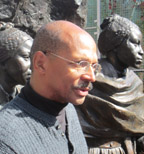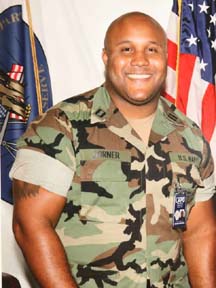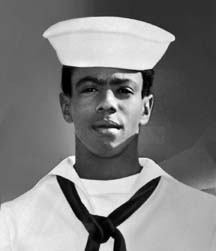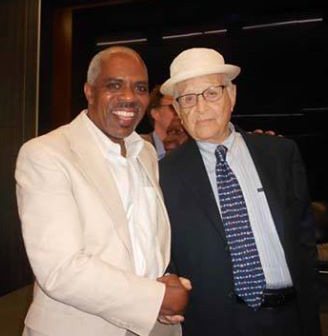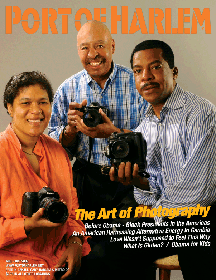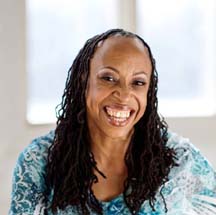If Opening From an E-mail,
Click Here for Better Viewing
September 29 – October 12, 2016
On The Dock This Issue:
 |
Black Men Who Used Guns to Solve America’s Race Problem – Part II "He knows what he's doing," Charlie Beck, the head of the LAPD, told reporters while the shooter was at large. "We trained him." | |
|---|---|---|
| North Carolina Goddam Today, North Carolina seems to want to take Mississippi’s spot. |
||
| Brexit, Africa, and Black America Because of Brexit, Britain leaving the European Union, “we may see a more unified African Union.” |
||
| Must See: America Divided on EPIX-TV The five part documentary has Norman Lear, Common, and Shonda Rhimes as executive producers. |
||
| Jason Miccolo Johnson’s Images in New Museum POH photographer has about 50 photographs in the new National Museum of African American History and Culture’s collection. |
||
| Vote USA 2016 Pop Quiz and link to vote registration in your state |
||
| Activities Interesting, diverse things to do |
||
| Readers' Trends Port Of Harlem, Pinterest, and Facebook |
Similar to Micah Xavier Johnson and Gavin Long (see Part 1 of this series), the United States government had trained Christopher Dorner and Mark Essex in the use of firearms. And separately, Dorner and Essex, used those skills to react to America’s lingering race problem.
During Black History Month, 2013, one of the largest manhunts in the history of the Los Angeles Police Department (LAPD) took place. The target was Dorner, a 33-year-old, ex-naval reservist, who had served in the Middle East and had, as he believed, been wrongfully dismissed from the LAPD because of racism.
A skilled marksman, Dorner killed four people, including the daughter of a police captain and her fiancé, and wounded six police officers. He had evaded an unprecedented 21st century police dragnet for just over a week. A million dollar reward was announced for his capture.
"He knows what he's doing," Charlie Beck, the head of the LAPD, told reporters while the shooter was at large. "We trained him."
The book "Crimes of the Century” noted that "In the early days of his shooting spree, Dorner allegedly authored a manifesto exacting revenge on the LAPD for spoiling his good name and unjustifiably firing him. At about 11,000 words, Dorner's meandering manifesto lays bare all his motivations. "I want my name back, period," Dorner wrote, "There is no negotiation."
He acknowledged his actions were "horrendous," shocking," and "drastic.” Dorner listed the many episodes of racism, discrimination, and injustice that he had witnessed and endured. He warned the LAPD that the "Violence of Action will be HIGH" against them using unconventional and asymmetric warfare to those ”on or off duty."
The police announced during the manhunt that Dorner's dismissal would be reexamined. "I do not do this,” the chief of police explained, to appease a murderer. “I do it to reassure the public that their police department is transparent and fair in all the things that we do."
However, during the search, nervous police shot several innocent bystanders by mistake and misidentified vehicles as Dorner's when they bore no resemblance to the official descriptions.
Dorner died of a self-inflicted gunshot at a remote mountaintop cabin on February 12, 2013 as the police were closing in. They set fire to his cabin and allowed it to be consumed by the flames.
For this reason, California State Polytechnic University Professor Renford Reese insisted it’s not simply enough to dismiss Dorner as crazy. "Of course, he's a murderer, of course he did wrong, of course, we grieve for the families. But he is a product of our institutions - our education system, our military, our police. Somehow all these things converged to create a monster."
In 2015, Dorner's former police partner, a White female, sued the LAPD for racial discrimination claiming that her supervisors retaliated and discriminated against her because of the Dorner case and her being his training officer. She asserted that she was denied promotions and overtime pay.
A low budget film: "Dorner: Manifesto for Murder" was produced the year after the shooting. During his shooting spree, Dorner received 3,819 'likes' on Facebook.
During Black History Month, 2013, one of the largest manhunts in the history of the Los Angeles Police Department (LAPD) took place. The target was Dorner, a 33-year-old, ex-naval reservist, who had served in the Middle East and had, as he believed, been wrongfully dismissed from the LAPD because of racism.
A skilled marksman, Dorner killed four people, including the daughter of a police captain and her fiancé, and wounded six police officers. He had evaded an unprecedented 21st century police dragnet for just over a week. A million dollar reward was announced for his capture.
"He knows what he's doing," Charlie Beck, the head of the LAPD, told reporters while the shooter was at large. "We trained him."
The book "Crimes of the Century” noted that "In the early days of his shooting spree, Dorner allegedly authored a manifesto exacting revenge on the LAPD for spoiling his good name and unjustifiably firing him. At about 11,000 words, Dorner's meandering manifesto lays bare all his motivations. "I want my name back, period," Dorner wrote, "There is no negotiation."
He acknowledged his actions were "horrendous," shocking," and "drastic.” Dorner listed the many episodes of racism, discrimination, and injustice that he had witnessed and endured. He warned the LAPD that the "Violence of Action will be HIGH" against them using unconventional and asymmetric warfare to those ”on or off duty."
The police announced during the manhunt that Dorner's dismissal would be reexamined. "I do not do this,” the chief of police explained, to appease a murderer. “I do it to reassure the public that their police department is transparent and fair in all the things that we do."
However, during the search, nervous police shot several innocent bystanders by mistake and misidentified vehicles as Dorner's when they bore no resemblance to the official descriptions.
Dorner died of a self-inflicted gunshot at a remote mountaintop cabin on February 12, 2013 as the police were closing in. They set fire to his cabin and allowed it to be consumed by the flames.
For this reason, California State Polytechnic University Professor Renford Reese insisted it’s not simply enough to dismiss Dorner as crazy. "Of course, he's a murderer, of course he did wrong, of course, we grieve for the families. But he is a product of our institutions - our education system, our military, our police. Somehow all these things converged to create a monster."
In 2015, Dorner's former police partner, a White female, sued the LAPD for racial discrimination claiming that her supervisors retaliated and discriminated against her because of the Dorner case and her being his training officer. She asserted that she was denied promotions and overtime pay.
A low budget film: "Dorner: Manifesto for Murder" was produced the year after the shooting. During his shooting spree, Dorner received 3,819 'likes' on Facebook.
Mark Essex
In "A Terrible Thunder: The Story of the New Orleans Sniper," Peter Hernon described a fateful incident and its immediate aftermath: "On a warm August day in 1970 there was a fistfight just outside the mess hall at the sprawling Naval Air Station at Imperial Beach, California. The combatants were Seaman Mark Robert Essex, a Black, and a White petty officer. A racial slur triggered the fight."
"He knows what he's doing," Charlie Beck, the head of the LAPD, told reporters while the shooter was at large. "We trained him."
The altercation was a watershed moment for the Black sailor, only in his early twenties. This was the first time he had struck a White man. After looking back on the event, Essex, according to Hernon, said to a fellow Black seafarer: "If a Black sailor can't get a fair shake when he's in the right, then to hell with the whole United States Navy.”
He became fair game for anyone with a grudge and even a sliver of seniority. Essex went AWOL in October 1970. He was court martialed and expelled from the Navy for what were described as character and behavior disorders. Then, the hopeful young recruit from a small town in Kansas who had scored well on his initial Navy tests and succeeded superbly in his advanced individual training - - died inside.
He began to study the rhetoric of extreme elements of the Black Panther movement. He moved to New Orleans, Louisiana to meet a comrade who shared his views. His parents were shocked that he had moved to a citadel of southern prejudice to live. He began to advocate violence as the only solution for Black people. The almost daily assault of Jim Crow indignities and violence stoked his growing inner fury. He covered the walls of his apartment with expressions of his deepening slide into ferocity: "Kill All Whites," "Beasts of the Earth," and ‘Big Devils."
He saw the police as the main oppressors of Black people. They would be his intended targets. As the Big Easy prepared to celebrate Christmas, 1972, Essex sent a note to WWL-TV announcing a New Year’s Eve attack on the city police department.
As he had suggested, Essex killed a police cadet and an officer who pursued him on December 31st. He evaded capture for a week. Essex then went into the downtown Howard Johnson's Motor Lodge on Loyola Avenue. Once inside, he killed several Whites, told the Blacks he encountered he was only after Whites.
He set fires in several rooms as he made his way to the roof. Once there, he continued to shoot at police although at least one African American was wounded. Ultimately, Essex killed seven people, including three police officers, and wounded eight.
The police brought in a helicopter to pour gunfire into his position, a concrete shelter on the roof. Police snipers also took aim at Essex from neighboring rooftops. He died with 200 gunshot wounds
"If he had not been mistreated in the Navy, he wouldn't have been gullible or easily influenced by outside influences," concluded his father. His mother added, "It’s a clear signal for White America to get off the seat of its pants and do something" about racial injustice."
Black Men Who Used Guns to Solve America’s Race Problem – Part I of III
Barely mentioned was Johnson's receipt of several awards, for example, "honorable active military service" and "meritorious achievement or service."
Black Men Who Used Guns to Solve America’s Race Problem – Part III of III
The African American community celebrated the story of Robert Charles. He was a Black man who stood up and fought back.
Note:
- See Gibbs's updated schedule of free Black history lectures
When Nina Simone recorded Mississippi Goddam, the Magnolia State was the premier symbol or White racism. Today, North Carolina seems to want to take Mississippi’s spot.
- Marriage Equality: Three couples sued in December over the law the North Carolina General Assembly passed last year that allows local magistrates, who can preside over marriages, to opt out of performing all marriages if they have a “sincerely held religious objection.” The law and litigation also covers assistant and deputy registers of deeds who issue marriage licenses.
- Redistricting: “Before enacting that law, the legislature requested data on the use, by race, of a number of voting practices,” Judge Diana Gribbon Motz wrote as she struck down a North Carolina voting law. “Upon receipt of the race data, the General Assembly enacted legislation that restricted voting and registration in five different ways, all of which disproportionately affected African Americans.”
- Transgender Inclusion: After joining Mississippi in passing restrictive measures and being hit by celebrity and corporate boycotts and a civil rights lawsuit brought by the U.S. Department of Justice, lawmakers in North Carolina are quietly at work to roll back parts of the state’s new law that effectively banned transgender individuals from deciding on their own which bathrooms to use, as well as gutted many state-level civil rights protections for women, minorities, and people of faith.
- Voter IDs: - North Carolina's emergency application to the Supreme Court to reinstate a controversial set of voting restrictions before November's election has been denied by a deadlocked, 4-4 court. The state failed to convince at least five justices that three provisions of the contested law ― its voter ID requirement, cutbacks to early voting, and elimination of pre-registration for certain under-18 voters ― were worth putting back on the books.
and in the original Mississippi
- Cleveland, MS has two high schools, one virtually all Black, the other about 50 percent Black and 50 percent White. Whites think that is enough integration, a federal court disagrees. The 50 year battle in Cleveland continues, the three White board members disagree with the courts, the two Black agree.
Coretta Scott King
January 22, 2004

". . . educate all children and inoculate them against the toxic viruses of racism, sexism, homophobia, anti-semitism, xenophobia and all forms of bigotry."
Because of Brexit, Britain leaving the European Union, “we may see a more unified African Union,” says Stephen Lande, an international trade expert in the United States. Being unified, he exerts, will allow Africa to make better trade deals he reasons. Lande, President of Manchester Trade, was part of a panel exploring the impact Brexit will have on Africa.
From the audience, Francois Hentschel, Counselor with the South African Embassy, asserted that future trade deals need to be “more inclusive.” He went on to explain that larger trading blocks, like the European Union and the United States, often insist on deals that override local concerns about a more equitable distribution of wealth and income.
Similar to problems in Black America, the discussion also touched on how trade deals often impact workers in communities that lack ownership in companies doing business in their communities. For instance, the booming cut flower industry in Kenya is controlled by Europeans and Israelis just as the African-American hair care supply retail industry is controlled by Koreans.
From the audience, Francois Hentschel, Counselor with the South African Embassy, asserted that future trade deals need to be “more inclusive.” He went on to explain that larger trading blocks, like the European Union and the United States, often insist on deals that override local concerns about a more equitable distribution of wealth and income.
Similar to problems in Black America, the discussion also touched on how trade deals often impact workers in communities that lack ownership in companies doing business in their communities. For instance, the booming cut flower industry in Kenya is controlled by Europeans and Israelis just as the African-American hair care supply retail industry is controlled by Koreans.
Though James Winkler, a senior trade and investment advisor with Development Alternatives Incorporated, sees Africa as having a brighter future, he says that only Nigeria and South Africa currently have significant trading with Europe. And, much of the trade, he says, is concentrated in oil and precious metals.
“Remittances have outstripped foreign trade,” he continued. He also agreed with Francious citing that fair trade also impact social problems, “You cannot kill Boko Harem with just military might,” he explained, echoing the same logic often used by those advocating solutions for America’s social ills including youth gang violence. The Society for International Development sponsored the talk.
“Remittances have outstripped foreign trade,” he continued. He also agreed with Francious citing that fair trade also impact social problems, “You cannot kill Boko Harem with just military might,” he explained, echoing the same logic often used by those advocating solutions for America’s social ills including youth gang violence. The Society for International Development sponsored the talk.
EPIX television will premiere "America Divided," an original five part documentary with Norman Lear, Common, and Shonda Rhimes as executive producers. The series explores inequlity in education, housing, immigration, healthcare, labor, criminal justice, and the political system.
Norman Lear (All in the Family, The Jefferson’s, Maude, Good Times, etc) was in Washington recently at the Brookings Institute to preview the show. "America Divided" was great, clear, concise, informative, even entertaining.
Photographer Jason Miccolo Johnson, who shot three covers for Port Of Harlem magazine, has about 50 photographs in the new National Museum of African American History and Culture’s collection. “Some are part of slides shows,” says the former Washington, D.C. resident. So, while at the museum in Washington, D.C., you may not readily see his name associated with the images unless you look at the image’s documentation.
However, in the slide show “Making a Way out of Now Way: Foundation of Faith,” you may recognize his photograph “Baptism in Chesapeake Bay.” The image is also in his book “Soul Sanctuary: Images of the African-American Worship Experience.” While the museum has his images integrated though out its exhibits, the Community and Cultural gallery are home to most of them.
However, in the slide show “Making a Way out of Now Way: Foundation of Faith,” you may recognize his photograph “Baptism in Chesapeake Bay.” The image is also in his book “Soul Sanctuary: Images of the African-American Worship Experience.” While the museum has his images integrated though out its exhibits, the Community and Cultural gallery are home to most of them.
The museum’s curators, who are experts in African-American history and history being made, were familiar with “Soul Sanctuary” before they met the Memphis native. After selecting several images, they made arrangements with Johnson to acquire them.
“I think it is an honor and a validation of the quality of my life-long work and my most important book to date,” added Johnson from his new home in Savannah, Georgia. In Georgia, Johnson is teaching photojournalism to the next generation at historically Black Savannah State University.
“I think it is an honor and a validation of the quality of my life-long work and my most important book to date,” added Johnson from his new home in Savannah, Georgia. In Georgia, Johnson is teaching photojournalism to the next generation at historically Black Savannah State University.
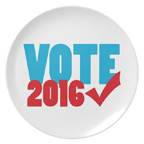 - Trump debating Clinton Mon, Sep 16: I agree with her on one thing. The single greatest problem the world has is nuclear armament, nuclear weapons, not global warming, like you think and your -- YOUR president thinks.
- Trump debating Clinton Mon, Sep 16: I agree with her on one thing. The single greatest problem the world has is nuclear armament, nuclear weapons, not global warming, like you think and your -- YOUR president thinks.- Civil Rights Museum Denies 'Special Request' by Trump Campaign (Trump staff was aggressive, rude, and insincere)
U.N. panel: U.S. owes Black people reparations for a history of ‘racial terrorism.’
- Pop Quiz From Electoral-Vote.Com:
Pop quiz - What do Alabama, Arkansas, Missouri, Nebraska, North Dakota, South Dakota, Tennessee, West Virginia, Wyoming and Mississippi have uniquely in common, when it comes to American politics?
The answer, as The Guardian observes, is that these are the 10 states where every single statewide election since Reconstruction has been won by a White person.
It is not a coincidence that these states could fairly well be said to form the backbone of the GOP's "red wall." It's also not a coincidence that nearly all of the states on the list (Wyoming and West Virginia are the exceptions) have adopted Voter ID laws. But the dwindling size of the list, and the relatively meager 61 EVs they control, should give Reince Priebus & Co. pause. It's just another illustration that a foundation made up nearly exclusively of White voters (and White officeholders) is a loser, long-term.
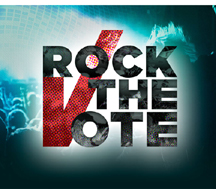
- Click here to register to Vote
- When does early voting start in every state?
- The U.S. Vice Presidential debate is Tuesday, October 4, 9p, ET between two men with very different historical relationships with the Black community.
Here are some examples:
Tim Kaine practiced law in Richmond for 17 years, specializing in fair housing law and representing clients discriminated against on the basis of race or disability. He represented in a landmark redlining discrimination lawsuit against Nationwide Mutual Insurance Co. He was chosen Richmond mayor by an 8-1 vote by the majority-Black City Council, becoming the city's first White mayor in more than ten years.
An HIV outbreak in majority White Southern Indiana caused Gov. Mike Pence to declare a health emergency and reversal in his opposition to needle-exchange programs - - a proven health strategy that he had continued to oppose for heavily Black Lake (Gary) and Marion (Indianapolis) counties. Rep. Charlie Brown, D-Gary, led to the charge to expand the program.
Washington
5th Annual NAAHP Conference on Haiti and its Diaspora
Howard University
Thu, Sep 29-Sat, Oct 1, $50-$350
History Makers School Visits
History Makers from Maureen Bunyon (Montgomery–DC)
to Martha Reeves (MLK–Detroit) visit local high schools
Fri, Sep 30, free
Tiempo Libre
Publick Playhouse
5445 Landover Road
Cheverly, MD
Sat, Oct 1, 8p, $25
Feng Shui Tea Happy Hour
with Sherry Burton Ways
Calabash Teahouse & Cafe
1847 7th St NW
Wed, Oct 5, 6 p-7:30p, free
Amateur Night Auditions
Cramton Auditorium
Howard University
Sat, Oct 1, 10a, free
Children's Africana Book Awards Festival
hosted by Smithsonian National Museum of African Art
950 Independence Ave, SW
Sat, Oct 8, 11p, free
5th Annual NAAHP Conference on Haiti and its Diaspora
Howard University
Thu, Sep 29-Sat, Oct 1, $50-$350
History Makers School Visits
History Makers from Maureen Bunyon (Montgomery–DC)
to Martha Reeves (MLK–Detroit) visit local high schools
Fri, Sep 30, free
Tiempo Libre
Publick Playhouse
5445 Landover Road
Cheverly, MD
Sat, Oct 1, 8p, $25
Feng Shui Tea Happy Hour
with Sherry Burton Ways
Calabash Teahouse & Cafe
1847 7th St NW
Wed, Oct 5, 6 p-7:30p, free
Amateur Night Auditions
Cramton Auditorium
Howard University
Sat, Oct 1, 10a, free
Children's Africana Book Awards Festival
hosted by Smithsonian National Museum of African Art
950 Independence Ave, SW
Sat, Oct 8, 11p, free
Hand to God
Studio Theater
14th and P, NW
extended through Sun, Oct 9, $20-$70
Blackberry Daze
MetroStage
1201 North Royal Street
Alexandria, Virginia
Thu, Sep 1-Sun, Oct. 9, $55-$66
Chicago/Gary
UniverSoul Circus
Washington Park 51st & Cottage Grove
through Sun, Oct 30, $
New York
Miriam Makeba: Mama Africa the Musical
NYU Skirball Center for Performing Arts
566 LaGuardia Place
Mon, Oct 3, 7:30, $25(students) $40
TV
Getting Ahead with Tavis Smiley
(documentary about the impact of the rising minimum wage)
PBS, Fri, Oct 7, 9p (ET), free
Studio Theater
14th and P, NW
extended through Sun, Oct 9, $20-$70
Blackberry Daze
MetroStage
1201 North Royal Street
Alexandria, Virginia
Thu, Sep 1-Sun, Oct. 9, $55-$66
Chicago/Gary
UniverSoul Circus
Washington Park 51st & Cottage Grove
through Sun, Oct 30, $
New York
Miriam Makeba: Mama Africa the Musical
NYU Skirball Center for Performing Arts
566 LaGuardia Place
Mon, Oct 3, 7:30, $25(students) $40
TV
Getting Ahead with Tavis Smiley
(documentary about the impact of the rising minimum wage)
PBS, Fri, Oct 7, 9p (ET), free
| From the Last Issue | On Pinterest | On Facebook | On Website | |||
|---|---|---|---|---|---|---|
 National Museum of African American History and Culture Opens |
 No More Condoms? |
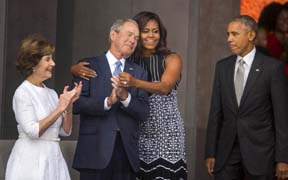 Hug it out: Michelle Obama embraces George W Bush |
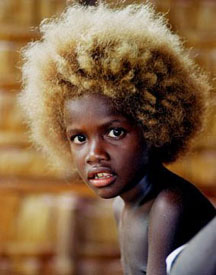 Surviving the South Pacific |






